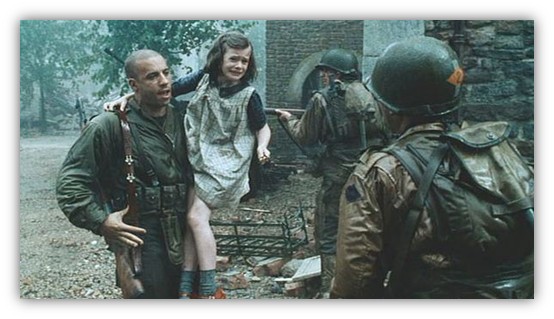Saving Private Ryan (1998), directed by Steven Spielberg, is an acclaimed war film known for its realistic and intense depiction of combat. Set during World War II, the film follows a group of U.S. soldiers sent on a mission to rescue Private James Ryan after his brothers are killed in action. I chose this film because of its unflinching portrayal of battlefield violence, immersive cinematography, and innovative editing techniques, which make it an ideal case study for analyzing the depiction of violence in Hollywood action films.
The scene takes place in a war-ravaged French village, with the mise-en-scène emphasizing the destruction and chaos of battle. The setting is filled with debris, broken buildings, and thick dust in the air, reinforcing the devastation of war. The lighting is natural and diffused, creating a muted, somber tone that enhances the realism.
Caparzo, wearing his standard-issue military gear, is positioned in the open, making himself vulnerable as he cradles the child. The blocking of characters is crucial—while Caparzo is exposed, his fellow soldiers remain behind cover, emphasizing the tension and the danger of his actions. The child, barefoot and fragile, contrasts sharply with the armed soldiers, highlighting the innocence caught amidst war.
The color palette is desaturated, dominated by grays and browns, contributing to the bleak atmosphere. The cinematography uses a handheld camera, adding a documentary-like feel, making the audience feel as if they are in the middle of the action. The moment of Caparzo’s death is sudden and brutal—the camera shifts to a sniper’s perspective, showing how his attempt at kindness leads to his downfall. Blood and rain mix in a symbolic representation of both sacrifice and futility.
Contemporary action films frequently employ similar mise-en-scène techniques to heighten the intensity and realism of violence. The use of desaturated color palettes, handheld cinematography, and rapid editing is prevalent in modern war and action films, immersing the audience in chaotic, high-stakes combat. Much like Saving Private Ryan, contemporary action films often blur the line between entertainment and realism, crafting visually compelling yet emotionally jarring depictions of violence. The prevalence of self-sacrificial characters, like Caparzo, further reinforces the genre’s recurring themes of duty, loss, and the harsh realities of warfare.
The real-life consequences of violent action films remain a widely debated topic. Research suggests that prolonged exposure to violent media can contribute to increased aggression and desensitization to violence in viewers.1 While Saving Private Ryan strives for historical accuracy rather than glorification, many action films prioritize spectacle over realism, potentially distorting perceptions of violence.2 Studies indicate that the hyper-masculine portrayals of soldiers and combatants in action films may reinforce gender stereotypes and skew public perceptions of military service.3 Additionally, the editing styles in these films—such as rapid cuts and shifting points of view—can alter the way audiences process visual information, sometimes reducing the emotional weight of violent acts.4 Despite these concerns, scholars argue that war films also serve as powerful educational tools, fostering historical awareness and critical discussions about the nature of warfare and heroism.5
________________________________________
1. Bender, Plante, and Gentile, “The Effects of Violent Media Content on Aggression.”
2. Kendrick, Film Violence: History, Ideology, Genre.
3. Steve Choe et al., The Palgrave Handbook of Violence in Film and Media
4. Neroni, Violence and Cinema.
5. Phillips, Violence, Media Effects, and Criminology
Saving Private Ryan is undoubtedly a profound example of how contemporary action films depict violence not merely as a plot device, but as a narrative force that shapes characters and themes. Through its meticulous attention to mise-en-scène—such as the chaotic, war-torn landscapes and the stark contrast between innocence and violence—the film forces the audience to confront the ugliness of conflict without romanticizing it. The handheld camera work and quick cuts draw the viewer into the action, creating a sense of immediacy that highlights the uncertainty and danger of warfare. However, despite these remarkable technical achievements, one cannot ignore the darker side of such cinematic depictions. While the film accurately portrays the horrors of war, its relentless violence, particularly in sequences like Caparzo’s death, raises questions about the emotional toll on the viewer. The graphic imagery can be emotionally overwhelming, and while it serves to create a visceral experience, it may also risk desensitizing audiences to real-world violence over time.
From an editing standpoint, the seamless integration of flashbacks, shifting points of view, and rapid transitions between close-ups and wide shots is effective in building tension. Yet, this constant switching of perspectives, especially in intense battle sequences, sometimes makes it difficult for the viewer to connect emotionally with the characters. The camera’s frantic movement often distances the audience, preventing them from fully processing the gravity of each scene. It raises an interesting question about the fine line between creating an immersive, action-packed experience and allowing for moments of reflective pause where the emotional weight of violence could resonate more deeply.
Ultimately, Saving Private Ryan illustrates the power of action films to explore violence, yet it also brings attention to the broader ethical considerations regarding how violence is portrayed and its impact on audiences. Whether through visual storytelling, the pacing of edits, or the framing of action sequences, the film pushes us to question the extent to which a film can ethically represent the violence of war while also offering a compelling experience.


Pedro Mori
I like how you immediately highlighted Saving Private Ryan’s dedication to realism. Many contemporary action movies tend to belong to the genre of popcorn flicks, but this is noticeably different. The contrast you brought up between the soldiers and the little girl’s outfits being a depiction of innocence being caught up in the fog of war is a subtle yet powerful example of the impacts that war can have on individuals. This also applies to the discussion of how the movie uses violence as a narrative device by combining frantic camera movements, desaturated imagery, and war-torn backgrounds. This gives the viewer an idea of the true brutal nature of war while not necessarily romanticizing it. I am also glad that you touched on this point in the conclusion. Balancing the dilemma between ethics and dramatization can be something difficult for the director because they want to make sure that viewers aren’t bored.
Your analysis of the scene is spot on, discussing how generosity and kindness are not always met with reward. Sometimes ending up in the worst case scenario, in this case, Caparzo’s death. It is also awesome how you pointed out the blood and the rain mixing. How it is meant to serve a symbolic shot about the consequences of war.
One thing I would have changed may have been putting all your sources in one paragraph. I think all of your paragraphs are relatively strong, but having your sources in other locations would add layers to your argument and make it stronger.